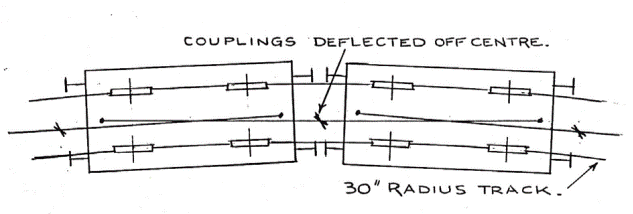Part 5: Final thoughts
Minimum running radius
Pulling a coupled train is permissible on quite small track radii. It will be seen below, however, that two wagons being pulled around a 30 inch radius causes the coupling wires to be offset from the centre. This results in a side force which increases as the radius gets smaller. Smaller radii can be used if using the hinged coupling due to a shorter length of wire being used between the coupling head and the hinge but this is not recommended for a number of reasons. For reliable running the minimum radius should be 30 inches. Pushing loose vehicles around a small radius is possible, however the coupling cannot in any way act as a centre buffer as the vehicle buffers must fulfil their proper function on curves.

Minimum radius for coupling and uncoupling
Coupling will not occur reliably if the vehicles are brought together on a track radius of less than 48 inches, due to the relative angles of the vehicles. If possible, always leave vehicles for recoupling on straight track. This follows prototypical practice where the coupling and uncoupling of vehicles is undertaken in straight track wherever possible. It is certainly not desirable to have the uncoupling electro-magnet positioned on track of a radius of much less than 48 inches.

Buffer stops
The precise nature of the setting of the coupling wires does not take kindly to harsh handling. and being rammed up against a solid object like a buffer stop is quite likely to disturb the setting. Rail built or other types of buffer stop should be made so that the cross beam is high enough to allow the nose of the coupling to pass under it.
Conclusion
The main objective behind the publication ‘Alex Jackson – The Man and the Coupling’ was to assemble into one document as much information as possible that had been written about the coupling thereby giving the builder all the information that was needed to construct working couplings. The book was an excellent document on the Alex Jackson Coupling from its birth to the time of the books publication, providing a ‘warts and all’ background into what the coupling was all about, and an account of how basic principles should always be applied to its construction. However what the book could never be was a definitive work on the coupling because that would suggest that the development of the AJ coupling had come to an end, which the book itself suggested was not correct by giving examples of new developments including its operation by DCC. Major developments not included in the book in any great detail were some of the jigs and the fittings produced by Palatine Models which significantly ease the construction of the coupling for the modeller and ensure consistency. How some of these jigs came into existence is described more fully in the section headed ‘A little bit of background information which explains how we got to where we are today’.
In stating the above it must be stressed that these pages do not attempt to provide a definitive description of the Alex Jackson coupling. Nor do they attempt to supersede the book. However, what they do is provide a useful supplement and update the publication where further developments have taken place or useful products introduced.
The Alex Jackson coupling has been in existence for many years, although its operation has changed significantly from when it was first devised. What has not changed are its basic dimensions and it cannot be stressed enough to adhere to these to achieve reliable coupling and uncoupling. It is accepted that there are a few people who have chosen to change some of the dimensions to suit their own needs, and if these changes suit their requirements and the coupling operates successfully then this goes to prove how flexible the design actually is! However it is known from comments received that some modellers have changed dimensions and have been hit with problems from the start. All that can be said is that the basic dimensions have been proved to work so if changes are causing problems please keep to those quoted, they have been proved to work and work well for many years.